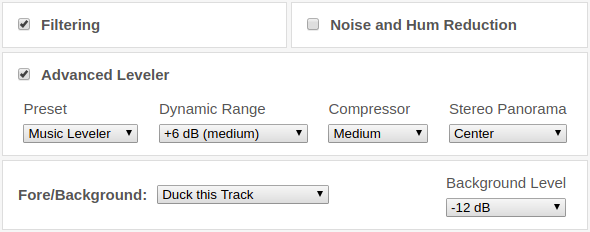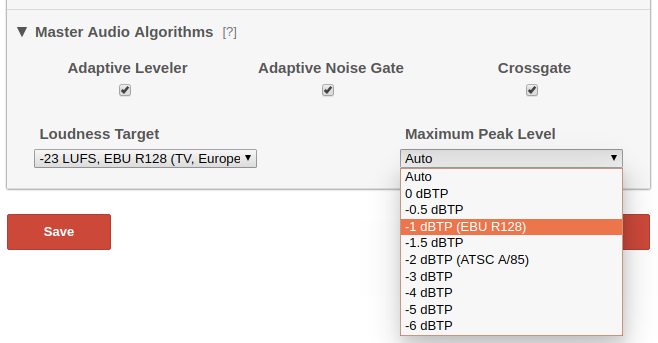Last weekend, at the Subscribe10 conference, we released Advanced Audio Algorithm Parameters for Multitrack Productions:

We launched our advanced audio algorithm parameters for Singletrack Productions last year. Now these settings (and more) are available for Multitrack Algorithms as well, which gives you detailed control for each track of your production.
The following new parameters are available:- Fore/Background Settings: keep your music/clip tracks unchanged and set a custom background gain
- Multitrack Leveler Parameters: control the stereo panorama, leveling algorithm, dynamic range and compression
- Better Hum and Noise Reduction Controls for each track
- Maximum True Peak Level setting for the final mixdown
- Full API Support
Please join our private beta program and let us know how you use these new features or if you need even more control!
Fore/Background Settings

The parameter Fore/Background controls whether a track should be in foreground, in background, ducked, or unchanged, which is especially important for music or clip tracks.
For more details, please see
Automatic Ducking, Foreground and Background Tracks
.
- Unchanged (Foreground):
-
We sometimes received complaints from users, which produced very complex music or clip tracks, that Auphonic
changes the levels too hard.
If you set the parameter Fore/Background to the new option Unchanged (Foreground), Level relations within this track won’t be changed at all. It will be added to the final mixdown so that foreground/solo parts of this track will be as loud as (foreground) speech from other tracks. - Background Level:
- It is now possible to set the level of background segments/tracks (compared to foreground segments) in background and ducking tracks. By default, background and ducking segments are 18dB softer than foreground segments.
Leveler Parameters

Similar to our Singletrack Advanced Leveler Parameters
(see this
previous blog post),
we also released leveling parameters for Multitrack Productions now.
The following advanced parameters for our
Multitrack Adaptive Leveler
can be set for each track and allow you to customize which parts of the audio should be leveled, how much they should be leveled, how much dynamic range compression should be applied and to set the stereo panorama (balance):
- Leveler Preset:
-
Select the Speech or Music Leveler for this track.
If set to Automatic (default), a classifier will decide if this is a music or speech track. - Dynamic Range:
-
The parameter Dynamic Range controls how much leveling is applied: Higher values result in more dynamic output audio files (less leveling). If you want to increase the dynamic range by 3dB (or LU), just increase the Dynamic Range parameter by 3dB.
For more details, please see Multitrack Leveler Parameters. - Compressor:
-
Select a preset for Micro-Dynamics Compression: Auto, Soft, Medium, Hard or Off.
The Compressor adjusts short-term dynamics, whereas the Leveler adjusts mid-term level differences.
For more details, please see Multitrack Leveler Parameters. - Stereo Panorama (Balance):
-
Change the stereo panorama (balance for stereo input files) of the current track.
Possible values: L100, L75, L50, L25, Center, R25, R50, R75 and R100.
If you understand German and want to know more about our Advanced Leveler Parameters and audio dynamics in general, watch our talk at the
Subscribe10 conference:
Video: Audio Lautheit und Dynamik.
Better Hum and Noise Reduction Controls
 We now offer three parameters to control the combination of our
Multitrack Noise and Hum Reduction Algorithms
for each input track:
We now offer three parameters to control the combination of our
Multitrack Noise and Hum Reduction Algorithms
for each input track:
- Noise Reduction Amount:
-
Maximum noise and hum reduction amount in dB, higher values remove more noise.
In Auto mode, a classifier decides if and how much noise reduction is necessary (to avoid artifacts). Set to a custom (non-Auto) value if you prefer more noise reduction or want to bypass our classifier. - Hum Base Frequency:
- Set the hum base frequency to 50Hz or 60Hz (if you know it), or use Auto to automatically detect the hum base frequency in each speech region.
- Hum Reduction Amount:
-
Maximum hum reduction amount in dB, higher values remove more noise.
In Auto mode, a classifier decides how much hum reduction is necessary in each speech region. Set it to a custom value (> 0), if you prefer more hum reduction or want to bypass our classifier. Use Disable Dehum to disable hum reduction and use our noise reduction algorithms only.
Behavior of noise and hum reduction parameter combinations:
| Noise Reduction Amount | Hum Base Frequency | Hum Reduction Amount | |
|---|---|---|---|
| Auto | Auto | Auto | Automatic hum and noise reduction |
| Auto or > 0 | * | Disabled | No hum reduction, only denoise |
| Disabled | 50Hz | Auto or > 0 | Force 50Hz hum reduction, no denoise |
| Disabled | Auto | Auto or > 0 | Automatic dehum, no denoise |
| 12dB | 60Hz | Auto or > 0 | Always do dehum (60Hz) and denoise (12dB) |
Maximum True Peak Level

In the Master Algorithm Settings of your multitrack production, you can set the maximum allowed true peak level of the processed output file, which is controlled by the True Peak Limiter after our Loudness Normalization algorithms.
If set to Auto (which is the current default), a reasonable value according to the selected loudness target is used: -1dBTP for 23 LUFS (EBU R128) and higher, -2dBTP for -24 LUFS (ATSC A/85) and lower loudness targets.
Full API Support
All advanced algorithm parameters, for Singletrack and Multitrack Productions, are available in our API as well, which allows you to integrate them into your scripts, external workflows and third-party applications.
Multitrack Advanced Audio Algorithm Settings
Join the Beta and Send Feedback
Please join our beta and let us know your case studies, if you need any other algorithm parameters or if you have any questions!
Here are some private beta invitation codes:
8tZPc3T9pH VAvO8VsDg9 0TwKXBW4Ni kjXJMivtZ1 J9APmAAYjT Zwm6HabuFw HNK5gF8FR5 Do1MPHUyPW CTk45VbV4t xYOzDkEnWP 9XE4dZ0FxD 0Sl3PxDRho uSoRQxmKPx TCI62OjEYu 6EQaPYs7v4 reIJVOwIr8 7hPJqZmWfw kti3m5KbNE GoM2nF0AcN xHCbDC37O5 6PabLBRm9P j2SoI8peiY olQ2vsmnfV fqfxX4mWLO OozsiA8DWo weJw0PXDky VTnOfOiL6l B6HRr6gil0 so0AvM1Ryy NpPYsInFqm oFeQPLwG0k HmCOkyaX9R G7DR5Sc9Kv MeQLSUCkge xCSvPTrTgl jyQKG3BWWA HCzWRxSrgW xP15hYKEDl 241gK62TrO Q56DHjT3r4 9TqWVZHZLE aWFMSWcuX8 x6FR5OTL43 Xf6tRpyP4S tDGbOUngU0 5BkOF2I264 cccHS0KveO dT29cF75gG 2ySWlYp1kp iJWPhpAimFWe are happy to send further invitation codes to all interested users - please do not hesitate to contact us!
If you have an invitation code, you can enter it here to activate the Multitrack Advanced Audio Algorithm Parameters:
Auphonic Algorithm Parameters Private Beta Activation